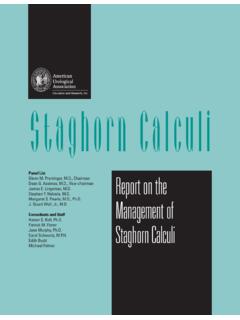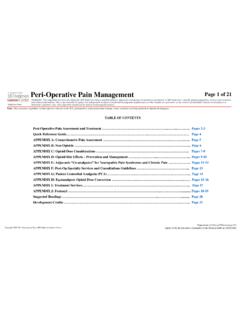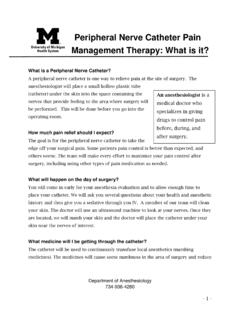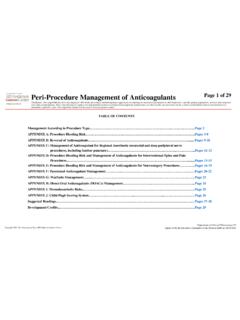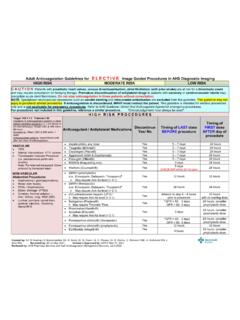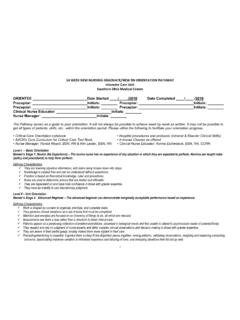Transcription of UNDERSTAND UROLOGY - American Urological Association
1 1 UNDERSTAND UROLOGY EXPLANATIONS OF CONFUSING UROLOGY ABBREVIATIONS Shea Mullaney Faraaz Zafar Kenneth Nepple, MD 2 We hope you find our introduction to UROLOGY lingo helpful. We attempted to be thorough yet concise. Please email omissions or suggestions for improvement to 3 A ADT = Androgen Deprivation Therapy: a form of prostate cancer treatment that works by decreasing testosterone levels to castrate levels (castration=bilateral testicle removal). Injections may be used in combination with radiation therapy for intermediate/high risk prostate cancer or as a palliative (not curative) therapy for metastatic prostate cancer. ADT was studied prior to prostatectomy and decreased positive surgical margin rate but did not improve any other outcome so is not used in that setting.
2 AMH = Asymptomatic Microscopic Hematuria: blood in the urine that is only found on microscopic examination and not visible to the naked eye (vs. visible gross hematuria - GH). The AUA guidelines define MH as >2 RBC per high powered field on a single microscopic exam. The standard workup is a CT urogram (CT without contrast, then with contrast and delayed imaging) and a cystoscopy. Cytology is recommended in patients with risk factors. Link to AUA Guidelines for AMH. AML = Angiomyolipoma: a benign renal mass composed of blood vessels (angio), muscle (myo), and fat (lipoma). Can be sporadic or seen as part of TS. Identified by fat on CT scan (negative HU); however, not all AMLs have fat visible on CT (fat-poor AML) and might not be identified until renal mass biopsy or surgery. AMLs are not cancer, but do have a risk of bleeding.
3 Typically managed conservatively if <3cm then treated with selective angioembolization by interventional radiology if >3 cm. ARF = Acute Renal Failure: abrupt loss of kidney function (synonym: acute kidney injury). Urologists typically 4 just make this diagnosis based on impression without using a strict definition. Many definitions exist, for example one criteria requires: Rapid time course (<48 hours) with reduction of kidney function defined by increase in serum creatinine (absolute increase of mg/dl OR increase of 50%) OR reduction in urine output to < ml/kg/h for more than 6 hours Compare to chronic kidney disease (CKD). AS = Active Surveillance: Not immediately treating very low risk or low risk prostate cancer, but instead monitoring for cancer progression. The ideal candidate has PSA <10, 2 or fewer cores, <50% involvement of any core, and PSA density of < AS can be employed because many prostate cancers grow slowly and may not progress (although prostate biopsy undergrades about one-third of prostate cancer compared to prostatectomy specimen).
4 Progression is assessed with PSA and DRE (typically every 3-6 months) and repeat prostate biopsy (at 12-18 months). Treatment may be initiated in patients that progress on monitoring. AS involves repeating prostate biopsy in men who are still felt to potentially benefit from treatment, in contrast to watchful watching where no treatment is done and men are watched until progression to metastatic disease or rise in PSA prompts ADT. AUASI = American Urologic Association Symptom Index (synonym IPSS): 7-question validated patient questionnaire designed to assess the severity of BPH symptoms of incomplete emptying, frequency, intermittency, urgency, weak stream, straining, and nocturia. Scored on a scale of 0-35 with scores of: 1-7 mild, 8-19 moderate, 20-35 severe. Link to AUA Score/IPSS form.
5 5 AUR = Acute Urinary Retention: common Urological emergency ( can t pee ), presents as sudden and typically painful inability to urinate. Most commonly due to BPH and not uncommon after surgery; other causes include urethral stricture, neurological disturbances (cauda equine syndrome), constipation, prostate or bladder cancer, diabetes, or medications (sympathetic cold medicine, anticholinergics, psych drugs). Initial management involves bladder drainage by urethral catheter (or suprapubic tube if unable to place a catheter ). AUS = Artificial Urinary Sphincter: implantable device that mimics the biological urinary sphincter by closing during urinary storage with a cuff that opens during voiding. An inflatable balloon cuff is surgically placed at the bulbar urethra and a pump in the scrotum to regulate its pressure with a fluid reservoir placed in the abdomen.
6 Treatment for post-prostatectomy SUI due to intrinsic sphincter deficiency. Link to picture of AUS AZF = Azospermia Factor: gene on the Y chromosome involved in spermatogenesis. Deletions within this region are associated with spermatogenic failure and male infertility. Genetic testing to identify AZF or chromosomal abnormalities is typically done if men have a sperm count <10 million/cc. B BC = Bladder Cystoscopy: diagnostic procedure that allows examination of the urethra (including visualization of the prostatic urethra), bladder, and ureteral orifices. A long, thin, flexible fiberoptic tube (15 French) or a larger rigid metal scope with a lens may be used. Cystoscope is inserted into the urethra under direct visualization. Used to 6 find cause of blood in urine, bladder stones, urethral blockages, or with various tools can be used for treatment (remove tissue for biopsy, remove bladder stones, place catheters, etc.)
7 BCG = Bacillus Calmette-Gu rin: intravesical (into the bladder) immunotherapy prepared from attenuated bovine tuberculosis bacillus. Used to decrease recurrence risk in non-muscle invasive bladder cancer (CIS or Ta or T1 high grade; typically not used for low grade.) The exact mechanism is unknown, but it is theorized that the bacteria in the bladder may trigger a localized immune reaction. Given as induction course (few weeks after TURBT give once weekly x 6 weeks) then later as maintenance (weekly x 3 weeks). BCR = Biochemical Recurrence: Rise in the PSA in prostate cancer patients after treatment with surgery or radiation (external beam or brachytherapy) which indicates prostate cancer recurrence. There are different definitions following prostatectomy (PSA > ng/ml) or following radiation (PSA ng/ml above the lowest PSA level detected following treatment = nadir + 2, called the Phoenix definition as the radiation meeting was in Phoenix when this was decided on).
8 BN = Bladder Neck: opening connecting the bladder to the urethra composed of layered sphincter muscles that control micturition. The bladder funnels to the bladder neck, thus the name. BNC = Bladder Neck Contracture: dense scar tissue at the bladder neck resulting in a stricture, can be asymptomatic or cause obstruction. A complication from radical prostatectomy, TURP, or radiation therapy. Patients can present with a decreased stream, urinary retention, or 7 incontinence. Typically treated with urethral dilation or a transurethral incision of the bladder neck contracture (TUIBNC). BOO = Bladder Outlet Obstruction: blockage of the bladder that reduces or prevents urine outflow. BPH is the most common cause; other common causes include bladder stones, bladder or pelvic tumors, urethral stricture, tumor, pelvic organ prolapse, or other less common causes (ureterocele=dilation of ureter).
9 Patients present with LUTS symptoms. UDS testing can be done to avoid misdiagnosis in patients where history is unclear. UDS helps to differentiate BOO from detrusor failure, which is when the bladder does not generate a contraction. BOO can be treated by relieving the cause of obstruction, while detrusor failure is typically managed by CIC to periodically drain the bladder (or by InterStim nerve stimulator in select patients). BPH = Benign Prostatic Hypertrophy/hyperplasia: common nonmalignant proliferation of stromal cells in the transitional zone of the prostate. Prostate growth increases with age and presence of DHT. Prostate hyperplasia can constrict the urethra (prostate sits like a donut around the urethra) and cause obstructive and irritative urinary symptoms. Severity of symptoms can be assessed with the AUASI (also called IPSS).
10 Medical treatment involves alpha blockers to relax the prostate and bladder neck smooth muscle and/or 5 alpha reductase inhibitors to decrease DHT stimulated prostate growth. Link to AUA guidelines for BPH BVI = Bladder Volume Index (synonym PVR): volume of urine remaining in the bladder after urination when measured by ultrasound (called a bladder scan, , to 8 nurse, please get a bladder scan on room 4 after he urinates ). Interpretation of values: 0 mL normal 10-100 mL usually not clinically significant >100 mL abnormal >999 mL because the digital display on the bladder scanner only has 3 digits, when the volume is greater than 999, this is what displays This value is typically pretty accurate, but can be confirmed by catheterization with a catheter without a balloon (straight cath) if you suspect the BVI is wrong or patient is obese or has ascites, which can make BVI inaccurate.
